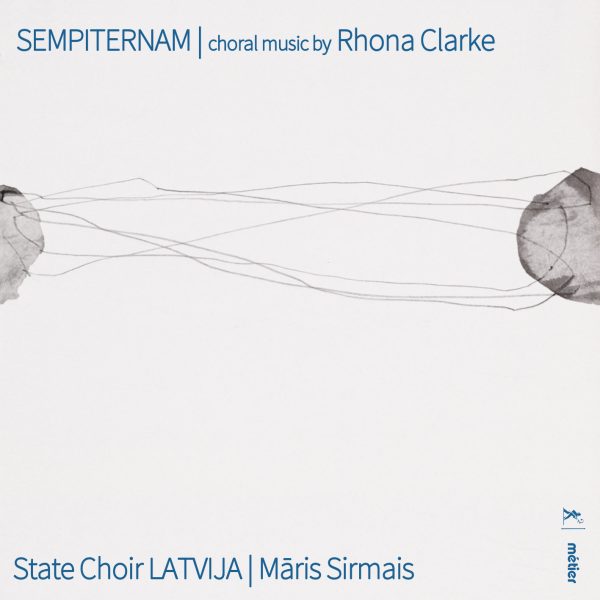IAWM Journal
This impressive CD by talented Irish composer Rhona Clarke consists of ten choral works—seven of which are commissions—composed over a period spanning thirty years (1991 to 2021). The disc demonstrates her diverse choral style and how she compellingly combines early style music with contemporary tonality. Clarke has a strong choral background. She joined a female voice choir in Dublin at the age of fifteen and continued to sing with various
university college choirs during her undergraduate and postgraduate studies. The first half of the CD is made up of a setting of a responsory text by twelfth-century composer Hildegard
von Bingen: Two Marian Anthems, a setting of Roman poet Catullus’ farewell lament to his brother, and Three Carols on Medieval Texts. The second half consists of five songs, which are more secular in character. Sandwiched in the middle is Requiem, a gem that Clarke composed in 2020. The SATB State Choir of Latvia, directed by Māris Sirmais, are the performers.
The opening track, O Vis Aeternitatis (2020), is set to Hildegard’s text. Dramatic in nature, it is peppered to good effect with open intervals, full harmonies, dissonant sounds, and
chanting. However, Clarke’s repeated use of upward and downward glissandos, which also appear in other tracks, sound gimmicky and perhaps a little trite.
The Two Marian Anthems (2007), Regina Caeli and Salve Regina, contrast well in style and texture. The former is jaunty,full of energy, and exhilarating, while the latter is more reflective with slow, sustained dissonances in keeping with the mournful, sighing, weeping text.
The unexpected foot stamping at the start of Ave Atque Vale (2018) and repeated thereafter, sets the scene for Catullus’ poignant elegy to his brother. This beautifully haunting funereal ode captivates the listener from the moment the male voices make their entry chanting ave atque vale (hail and farewell) followed by the female voices in fugal style. The abundant use of drones, chanting, dissonant voices, and theatrically spoken words are used to great effect to create an overwhelming expression of grief and sorrow.
The Three Carols (2014) are delightful and, in line with medieval texts, Clarke makes use of monophony, drones, open fifths, and simple counterpoint, especially in the first two carols. Glad and Blythe, which is bright and lively, contrasts well with the slow and sorrowful Lullay
my Liking. Make we Merry is upbeat and very much in the Christmas spirit with its staccato-like syncopated rhythms and mixed meters. Clarke’s fondness for open fifth intervals in the opening bars, especially between the tenors and basses, is also reflected in Do not Stand at
my Grave and Weep and The Old Woman.
The Requiem, in four movements, shows Clarke at her finest. The Introit begins with a very effective tenor and bass ostinato, which sets the tone for this magnificent piece. Over a very
low bass singing requiem, the tenors enter singing requiem aeternam (eternal rest). The upper voices then join in over the ostinato, culminating in all voices singing an emotionally charged exaudi orationem meam (hear my prayer) before the ostinato is restated. In the second movement, Lux Aeterna (eternal light), Clarke cleverly includes musical ornaments in the upper voices, an interval of a second apart “to create a shimmering texture.” In contrast, Pie Jesu is slow, soft, and gentle with a chorale like theme, repeated throughout by the sopranos and then performed by impressive solo soprano Anete Viluma. Such purity of sound and simplistic beauty embodies the essential characteristic of this movement. The last
movement, In Paradisum, the Gregorian chant antiphon is exquisitely performed by two solo sopranos, Viluma and Marika Austruma, with the choir adding harmonies and accompaniment.
The common thread between the five songs on the second half of the disc is Clarke’s skilful ability to ensure that the text plays an integral part of the composition. The Kiss (2008) is upbeat and lively, while A Song for St Cecilia’s Day (1991) reflects the power of music, referring to its healing qualities. Do not Stand at my Grave and Weep (2006), dedicated to
Clarke’s sister-in-law who was terminally ill at the time of writing, arouses emotions of tenderness as the sopranos, and later solo soprano, maintain the melodic line, accompanied by the choir’s swirling “ahs.” Set to an anonymous children’s rhyme, The Old Woman (2016) retains a humorous mood. After an initial bar of foot stamping, the tenors and basses
enter a fifth apart and repeatedly sing “skin and bone,” while the upper voices sing the melody. Rorate Caeli (1994) (Drop down ye Heavens) starts in a lively manner, after which the mood becomes subdued before finishing in unison with a defiant flourish on the word rorate. As exhibited throughout the entire recording, the Latvia State Choir is outstanding. The quality of their performance is first rate, not only in establishing an inspirational interpretation of Clarke’s music but also in ensuring clarity of words under the excellent directorship of Māris Sirmais.
@divineartrecordingsgroup
A First Inversion Company
Registered Office:
176-178 Pontefract Road, Cudworth, Barnsley S72 8BE
+44 1226 596703
Fort Worth, TX 76110
+1.682.233.4978












